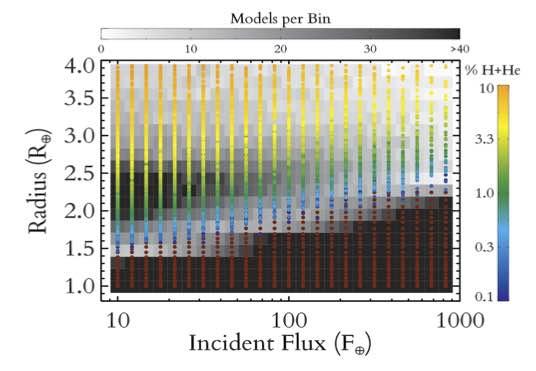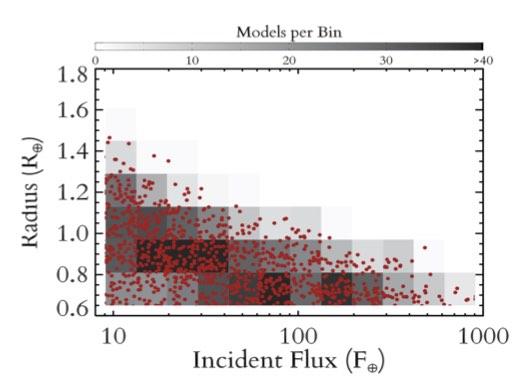Estimating eta-Earth
Understanding the origin of very close-in, rocky exoplanets can help us to constrain the frequency of Earth-like exoplanets on orbits where liquid water may exist on their surface.

One of most interesting recent discoveries in exoplanet science is that there is an abundance of planets with sizes between that of the Earth and that of Neptune. These appear to be common in the Galaxy, despite not being present in the Solar System. Furthermore, it appears that those that have radii below ~ 1.5 Earth radii tend to be rocky, while those with radii above ~ 2 Earth radii tend to retain quite a substantial atmosphere. However, most of these planets are quite heavily irradiated by their parent stars, and so we don’t really know if the rocky ones formed rocky, or are the exposed cores of planets that once had substantial atmospheres.
In a recent paper, we proposed a way in which we could test which scenario was most likely. If these close-in rocky planets are predominantly the exposed cores of planets that once had substantial atmospheres, then their radii should decrease as they move further from their parent stars. This is because the level of irradiation typically drops as you go further from the star. At larger orbital radii, where the irradiation is lower, atmospheres can only be stripped from planets with lower-mass cores. This is shown in the top figure on the right, where the x-axis is incident stellar flux (irradiation) which increases as you get closer to the star (i.e., small numbers means larger orbital radius).
On the other hand, if these are planets that formed rocky, their physical radii should increase with increasing orbital radius. This is because as you move further from the star, there is essentially more material available to build planets. This is shown in the lower figure on the right, with the x-axis again being incident stellar flux.
So, if you can determine how the radii of close-in rocky planets varies with orbital radius, you can say something about the origin of these very close-in rocky planets. We can’t, however, really do this yet, because we don’t have sufficiently accurate estimates of their radii, and because they currently don’t extend far enough in orbital radius. However, with the launch of ESA’s Gaia satellite and NASA’s Transiting Exoplanet Survey Satellite (TESS) we may soon be able to better constrain stellar, and hence planetary, radii and should also have a sample of these planets that extend to larger orbital radii.

One reason that this is important is because we might be able to use this inner population of rocky planets to say something about , the frequency of potentially habitable Earth-like planets (i.e., how common are rocky planets around Sun-like stars, orbiting where life might be able to exist). However, doing so requires knowing the origin of these planets. If they’re primordially rocky, then they may be the inner population of rocky planets that extend to larger orbital radii. On the other hand, if they are the exposed cores of planets that once hosted substantial atmosphere, then they’re really the inner population of planets that become more Neptune-like as you move to larger orbital radii. If we want to better constrain , then we really do need to know the origin of this population of inner rocky planets, which we should be able to determine quite soon.
Links:
Lopez, E. & Rice, K, How formation time-scales affect the period dependence of the transition between rocky super-Earths and gaseous sub-Neptunes and implications for η⊕, Monthly Notices of the Royal Astronomical Society, 479, 5303-5311, 2018.

